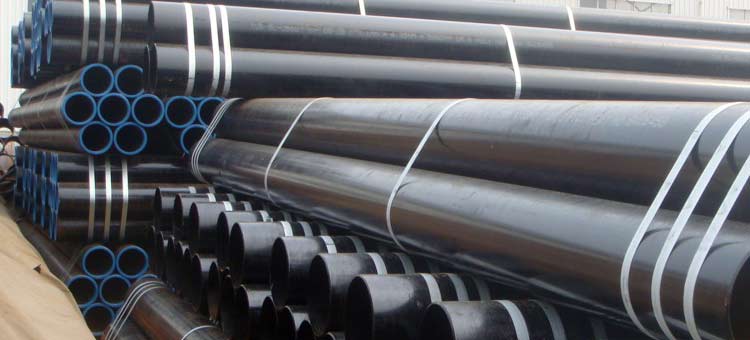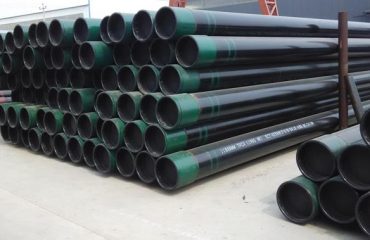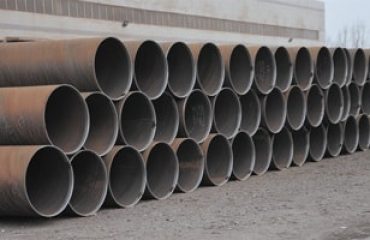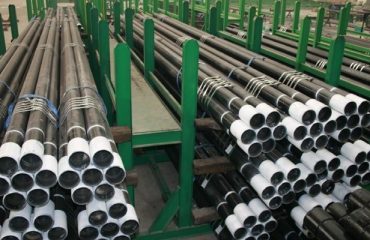
ASTM A672 soudé par électrofusion (EFW) Tuyau D'Acier
Introduction
ASTM A672 est une spécification qui couvre les soudures électriques par fusion (EFW) tuyaux en acier conçus pour un service haute pression à températures modérées. Ces tuyaux sont couramment utilisés dans des industries telles que la production d'électricité, de la pétrochimie, pétrole et de gaz, et transport d'eau. La spécification fournit des lignes directrices pour la fabrication, essai, et inspection des tuyaux en acier pour garantir qu'ils répondent aux propriétés mécaniques et aux exigences de performance nécessaires pour les applications à haute pression.
Le procédé EFW est une méthode de soudage qui utilise un arc électrique pour fusionner les plaques d'acier entre elles., former une couture longitudinale. Ce processus est très efficace et produit des tuyaux avec une excellente intégrité structurelle et une excellente résistance mécanique.. Les tuyaux ASTM A672 sont disponibles en différentes qualités en fonction du type d'acier utilisé et des propriétés mécaniques requises..
Cet article explorera le processus de fabrication, Propriétés mécaniques, et applications des tuyaux en acier ASTM A672 EFW, ainsi que les méthodes de test utilisées pour garantir leur qualité et performances.
Table des matières
- Qu'est-ce que le tuyau en acier ASTM A672 EFW?
- Processus de fabrication des tuyaux en acier ASTM A672 EFW
- Soudage par fusion électrique (EFW) Processus de
- traitement thermique
- Qualités et classes de tuyaux en acier ASTM A672
- Propriétés mécaniques des tuyaux en acier ASTM A672 EFW
- Exigences en matière de tests et d'inspection
- essais non destructifs (CND)
- Essais hydrostatiques
- Applications des tuyaux en acier ASTM A672 EFW
- Questions fréquemment posées (FAQ)
- Conclusion
Qu'est-ce que le tuyau en acier ASTM A672 EFW? {#qu'est-ce que le tuyau en acier astm-a672-efw}
ASTM A672 est une spécification standard pour les soudures électriques par fusion. (EFW) tuyaux en acier conçus pour un service haute pression à températures modérées. Ces tuyaux sont fabriqués à partir d'un récipient sous pression qualité plaques d'acier soudées par fusion à l'arc électrique. La spécification couvre les tuyaux avec un joint longitudinal et est destinée à être utilisée dans des applications où une résistance et une durabilité élevées sont requises..
Principales caractéristiques des tuyaux en acier ASTM A672 EFW:
-
Soudé par fusion électrique (EFW): Les tuyaux sont fabriqués selon le procédé EFW, qui consiste à fusionner les plaques d'acier ensemble à l'aide d'un arc électrique. Ce processus produit une soudure longitudinale solide qui peut résister à des pressions élevées.
-
Le Récipient À Pression qualité Acier: Les tôles d'acier utilisées dans la fabrication des tuyaux ASTM A672 sont de qualité appareil sous pression, ce qui signifie qu'ils sont conçus pour résister à des pressions internes élevées sans défaillance.
-
Service haute pression: Les tuyaux ASTM A672 conviennent aux applications haute pression, comme les chaudières, Les Échangeurs De Chaleur, et pipelines dans l'industrie pétrolière et gazière.
-
Applications à température modérée: La spécification couvre les tuyaux conçus pour être utilisés à des températures modérées, généralement jusqu'à 400°C (752F).
-
Diverses qualités: Les tuyaux ASTM A672 sont disponibles en différentes qualités en fonction du type d'acier utilisé et des propriétés mécaniques requises.. Les nuances sont déterminées par la composition chimique et le traitement thermique de l'acier.
Processus de fabrication des tuyaux en acier ASTM A672 EFW {#processus-de-fabrication-de-tuyaux-en-acier-astm-a672-efw}
La fabrication des tuyaux en acier ASTM A672 EFW comporte plusieurs étapes, y compris la sélection de plaques d'acier de qualité pour appareils sous pression, le soudage par fusion électrique (EFW) Processus de, et traitement thermique pour obtenir les propriétés mécaniques souhaitées.
Soudage par fusion électrique (EFW) Processus de {#procédé de soudage par fusion électrique efw}
Le procédé EFW est un type de soudage à l'arc qui utilise un arc électrique pour fusionner les plaques d'acier ensemble le long d'un joint longitudinal.. Le processus implique les étapes suivantes:
-
Préparation des assiettes: Les plaques d'acier sont d'abord découpées aux dimensions requises et inspectées pour déceler tout défaut ou imperfection de surface..
-
Préparation des bords: Les bords des plaques d'acier sont biseautés pour assurer une bonne fusion pendant le processus de soudage. L'angle de biseau est soigneusement contrôlé pour obtenir une soudure solide.
-
Soudage par fusion électrique: Les plaques sont positionnées bord à bord, et un arc électrique est utilisé pour faire fondre les bords des plaques, création d'un bain de soudure. À mesure que l'arc se déplace le long de la couture, le métal en fusion se solidifie, former une soudure continue sur toute la longueur du tuyau.
-
Inspection des soudures: La soudure est inspectée pour déceler des défauts tels que la porosité, fissures, ou fusion incomplète. Contrôle non destructif (CND) méthodes, comme les tests par ultrasons ou les tests radiographiques, sont souvent utilisés pour garantir la qualité de la soudure.
-
Dimensionnement et mise en forme: Après soudage, le tuyau passe à travers une série de rouleaux pour obtenir le diamètre et la rondeur souhaités. Le tuyau est également inspecté pour la précision dimensionnelle.
traitement thermique {#traitement thermique}
Après le processus EFW, les tuyaux peuvent subir un traitement thermique pour améliorer leurs propriétés mécaniques et soulager les contraintes résiduelles induites lors du soudage. Le type de traitement thermique dépend de la qualité de l'acier et des exigences de l'application.. Les processus de traitement thermique courants comprennent:
-
Normalisation: Le tuyau est chauffé à une température supérieure à son point critique puis refroidi à l'air. Ce procédé affine la structure du grain et améliore la ténacité de l'acier.
-
Trempe et revenu: Le tuyau est chauffé à haute température puis rapidement refroidi (éteint) dans l'eau ou l'huile. Il est ensuite réchauffé à une température plus basse (tempéré) pour améliorer sa ductilité et sa ténacité.
-
Déstressant: Le tuyau est chauffé à une température modérée puis refroidi lentement pour soulager les contraintes résiduelles sans altérer de manière significative les propriétés mécaniques..
Qualités et classes de tuyaux en acier ASTM A672 {#qualités-et-classes-de-tuyaux-en-acier-astm-a672}
Les tuyaux en acier ASTM A672 sont disponibles en différentes qualités et classes en fonction du type d'acier utilisé et des propriétés mécaniques requises.. Les nuances sont déterminées par la composition chimique de l'acier, tandis que les classes sont basées sur les exigences de traitement thermique et de test.
Notes communes:
-
Catégorie B60: Cette nuance est fabriquée à partir d'acier au carbone avec une résistance à la traction minimale de 415 MPa (60,000 psi). Il est couramment utilisé pour les applications à pression modérée.
-
Catégorie C65: Cette nuance est fabriquée à partir d'acier au carbone-manganèse avec une résistance à la traction minimale de 450 MPa (65,000 psi). Il convient aux applications à haute pression.
-
Catégorie C70: Cette nuance est fabriquée à partir d'acier au carbone-manganèse avec une résistance à la traction minimale de 485 MPa (70,000 psi). Il est utilisé dans les applications à haute pression où la résistance et la durabilité sont essentielles..
Cours:
- Classe 10: Les tuyaux de cette classe sont fournis à l'état brut de soudure, sans aucun traitement thermique..
- Classe 12: Les tuyaux de cette classe sont traités thermiquement après soudage pour améliorer leurs propriétés mécaniques et soulager les contraintes résiduelles.
- Classe 22: Les tuyaux de cette classe subissent une trempe et un revenu pour obtenir une résistance et une ténacité supérieures..
Spécification matérielle {#spécification du matériau}
ASTMA672 les tuyaux sont fabriqués à partir de plaques d'acier de qualité pour récipients sous pression qui sont soudés à l'aide du Soudage par fusion électrique (EFW) Processus de. La spécification couvre les tuyaux dans divers Grades et Cours, qui sont déterminés par le la composition chimique de l'acier et du traitement thermique appliqué après soudage.
Principales caractéristiques des tuyaux en acier ASTM A672 EFW:
- Soudé par fusion électrique (EFW): Les tuyaux sont soudés à l'aide d'un arc électrique fusionner des plaques d'acier, créer un soudure longitudinale.
- Acier de qualité pour récipients sous pression: Les tôles d'acier utilisées sont de qualité du récipient sous pression, s'assurer que les tuyaux peuvent résister pressions internes élevées.
- Service haute pression: Les tuyaux ASTM A672 sont conçus pour applications haute pression à températures modérées.
- Notes et classes: La spécification fournit plusieurs Grades et Cours basé sur le la composition chimique et traitement thermique de l'acier.
Tableau de composition chimique {#tableau-de-composition-chimique}
La composition chimique des tuyaux en acier ASTM A672 varie en fonction du Grade de l'acier utilisé. Le tableau ci-dessous présente la composition chimique typique des qualités courantes utilisées dans les tuyaux ASTM A672..
| ÉLÉMENT | Catégorie B60 (%) | Catégorie C65 (%) | Catégorie C70 (%) |
|---|---|---|---|
| CARBONE (C) | 0.26 Max | 0.24 Max | 0.23 Max |
| manganèse (Mn) | 0.98 Max | 1.20 Max | 1.35 Max |
| le phosphore (P) | 0.035 Max | 0.035 Max | 0.035 Max |
| soufre (S) | 0.035 Max | 0.035 Max | 0.035 Max |
| Silicium (Si) | 0.13-0.45 | 0.13-0.45 | 0.13-0.45 |
| chrome (Cr) | 0.30 Max | 0.30 Max | 0.30 Max |
| nickel (Ni) | 0.30 Max | 0.30 Max | 0.30 Max |
| Molybdène (Mo) | 0.12 Max | 0.12 Max | 0.12 Max |
| cuivre (Cu) | 0.40 Max | 0.40 Max | 0.40 Max |
| Vanadium (V) | 0.08 Max | 0.08 Max | 0.08 Max |
Remarques:
- Teneur en carbone est un facteur clé pour déterminer le Force et La dureté de l' de l'acier. Une teneur en carbone plus faible s'améliore soudabilité et ductilité.
- manganèse améliore le Force De Traction et trempabilité de l'acier.
- le phosphore et soufre sont maintenus à de faibles niveaux pour éviter fragilité et améliorer la ténacité.
- Silicium agit comme un désoxydant pendant le processus de fabrication de l'acier et améliore Force.
Tableau des propriétés mécaniques {#tableau des propriétés mécaniques}
Les propriétés mécaniques des tuyaux en acier ASTM A672 sont déterminées par les Grade et Classe du tuyau, ainsi que le traitement thermique appliqué après soudage. Le tableau ci-dessous fournit les propriétés mécaniques typiques des qualités courantes de tuyaux ASTM A672..
| Propriété | Catégorie B60 | Catégorie C65 | Catégorie C70 |
|---|---|---|---|
| Force De Traction (MPa) | 415 min (60,000 psi) | 450 min (65,000 psi) | 485 min (70,000 psi) |
| Limite d’élasticité (MPa) | 240 min (35,000 psi) | 275 min (40,000 psi) | 275 min (40,000 psi) |
| Élongation (%) | 22 min | 22 min | 22 min |
| Résistance aux chocs (J) | Varie selon la classe | Varie selon la classe | Varie selon la classe |
Remarques:
- Force De Traction est la contrainte maximale que le matériau peut supporter avant de se briser.
- Limite d’élasticité est la contrainte à laquelle le matériau commence à se déformer plastiquement.
- Élongation est une mesure de la ductilité du matériau, indiquant combien il peut s'étirer avant de se casser.
- Résistance aux chocs est généralement mesuré à l’aide Tests Charpy à encoche en V, en particulier pour les applications dans environnements à basse température.
Exigences en matière de tests et d'inspection {#exigences-de-test-et-d'inspection}
Pour garantir la qualité et les performances des tuyaux en acier ASTM A672 EFW, plusieurs méthodes de test et d'inspection sont utilisées pendant le processus de fabrication. Ces tests permettent d'identifier tout défaut ou incohérence dans le matériau ou la soudure qui pourrait compromettre les propriétés mécaniques ou l'intégrité structurelle du tuyau..
essais non destructifs (CND) {#contrôles-nondestructifs-ndt}
essais non destructifs (CND) des méthodes sont utilisées pour inspecter le cordon de soudure et le corps du tuyau à la recherche de défauts sans endommager le matériau. Les méthodes CND courantes incluent:
-
Essais par ultrasons (UT): Les ondes ultrasoniques sont utilisées pour détecter les défauts internes tels que les fissures, vides, ou fusion incomplète dans la soudure ou le corps du tuyau.
-
Test radiographique (RT): Les rayons X ou gamma sont utilisés pour créer une image de la soudure, permettant aux inspecteurs d'identifier les défauts internes tels que la porosité, inclusions de scories, ou des fissures.
-
Magnétoscopie (MT): Cette méthode est utilisée pour détecter les défauts de surface dans les matériaux ferromagnétiques. Un champ magnétique est appliqué au tuyau, et des particules de fer sont utilisées pour révéler toute fissure ou discontinuité sur la surface.
-
ressuage (PT): Un colorant est appliqué sur la surface du tuyau, et toutes les fissures ou défauts absorberont le colorant, les rendant visibles sous la lumière ultraviolette.
Essais hydrostatiques {#essais hydrostatiques}
Les tests hydrostatiques sont un test critique utilisé pour garantir que le tuyau peut résister à la pression interne à laquelle il sera soumis en service.. Lors de cet essai, le tuyau est rempli d'eau et pressurisé à un niveau supérieur à sa pression de fonctionnement. Le tuyau est ensuite inspecté pour détecter toute fuite ou déformation pouvant indiquer une faiblesse du matériau ou de la soudure..
- Test de pression: La pression d'essai est généralement 1.5 multiplié par la pression de conception du tuyau.
- Durée: Le tuyau est maintenu à la pression d'essai pendant une période spécifiée (généralement 5 À 15 minutes) pour s'assurer qu'il peut maintenir la pression sans défaillance.
Applications des tuyaux en acier ASTM A672 EFW {#applications-de-astm-a672-efw-steel-pipe}
Les tuyaux en acier ASTM A672 EFW sont utilisés dans un large éventail d'industries et d'applications où le service à haute pression et l'intégrité structurelle sont essentiels.. Certaines applications courantes incluent:
-
la production d'énergie: Les tuyaux ASTM A672 sont utilisés dans les chaudières, Les Échangeurs De Chaleur, et les conduites de vapeur dans les centrales électriques en raison de leur capacité à résister à des pressions élevées et à des températures modérées.
-
industrie pétrochimique: Ces tuyaux sont utilisés dans les raffineries, plantes chimiques, et installations pétrochimiques pour le transport de fluides et de gaz corrosifs sous haute pression.
-
Industrie du pétrole et du gaz: Les tuyaux ASTM A672 sont utilisés dans les oléoducs et les gazoducs, Plateformes offshore, et pipelines sous-marins pour transporter le pétrole brut, gaz naturel, et autres hydrocarbures.
-
Transport d'eau: Ces tuyaux sont utilisés dans les systèmes de transmission d'eau pour le transport de l'eau potable., eaux usées, et eaux industrielles sous haute pression.
-
Applications structurelles: Les tuyaux ASTM A672 sont utilisés dans des applications structurelles telles que les colonnes, poutres, et supports dans les bâtiments et les structures industrielles où résistance et durabilité sont requises.
Questions fréquemment posées (FAQ) {#FAQ}
1. Quelle est la différence entre les tuyaux EFW et ERW?
EFW (Soudé par fusion électrique) les tuyaux sont soudés à l'aide d'un arc électrique pour fusionner les plaques d'acier ensemble, tandis que les restes explosifs des guerres (Soudé par résistance électrique) les tuyaux sont soudés à l'aide d'une résistance électrique pour chauffer les bords de l'acier et les fusionner. Les tuyaux EFW sont généralement utilisés pour les applications haute pression, tandis que les tuyaux ERW sont utilisés pour les applications à pression faible à modérée.
2. Quelles sont les qualités courantes des tuyaux ASTM A672?
Les qualités courantes de tuyaux ASTM A672 incluent la qualité B60, Catégorie C65, et grade C70, qui sont basés sur la composition chimique et les propriétés mécaniques de l'acier.
3. Quelle est la température de fonctionnement maximale des tuyaux ASTM A672?
Les tuyaux ASTM A672 sont conçus pour être utilisés à des températures modérées, généralement jusqu'à 400°C (752F), en fonction du grade et de la classe du tuyau.
4. Comment la qualité des tuyaux ASTM A672 est-elle assurée?
La qualité des tuyaux ASTM A672 est garantie par des tests non destructifs (CND) des méthodes telles que les tests par ultrasons, Test radiographique, et tests de magnétoscopie, ainsi que des tests hydrostatiques pour vérifier la capacité du tuyau à résister à la pression interne.
5. Quelles industries utilisent les tuyaux en acier ASTM A672 EFW?
Les tuyaux en acier ASTM A672 EFW sont utilisés dans des industries telles que la production d'électricité, de la pétrochimie, pétrole et de gaz, et la transmission de l'eau en raison de leur capacité à résister à des pressions élevées et à des températures modérées.
Conclusion {#Conclusion}
Les tuyaux en acier ASTM A672 EFW sont conçus pour un service haute pression à des températures modérées, ce qui les rend idéaux pour une utilisation dans des industries telles que la production d'électricité, de la pétrochimie, pétrole et de gaz, et transport d'eau. le soudage par fusion électrique (EFW) le processus garantit une soudure longitudinale solide qui peut résister à des pressions internes élevées, tandis que l'utilisation d'acier de qualité pour récipients sous pression garantit que les tuyaux ont les propriétés mécaniques nécessaires pour les applications exigeantes..
Les exigences de test et d'inspection décrites dans ASTM A672, y compris les tests non destructifs et les tests hydrostatiques, aider à garantir la qualité et la performance des tuyaux, ce qui en fait un choix fiable pour les applications structurelles et à haute pression.




Vous devez être connecté dans pour poster un commentaire.